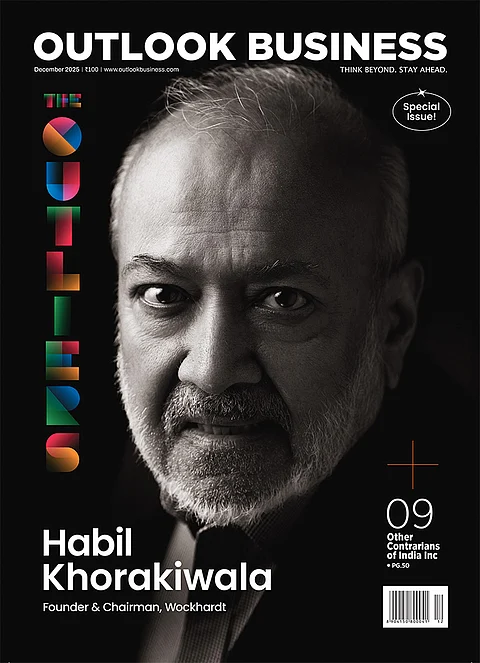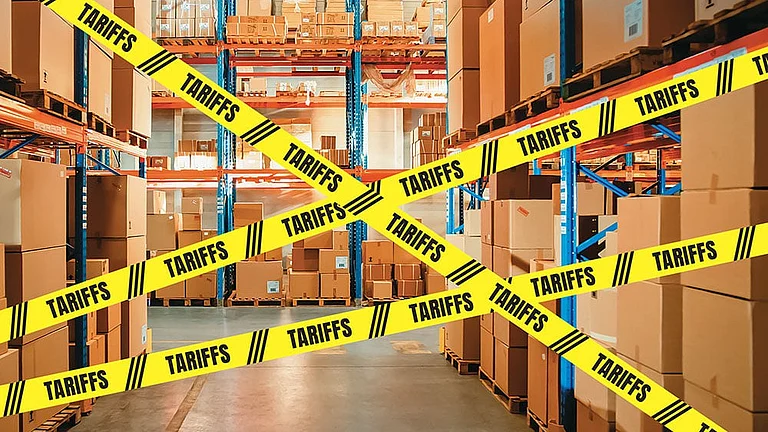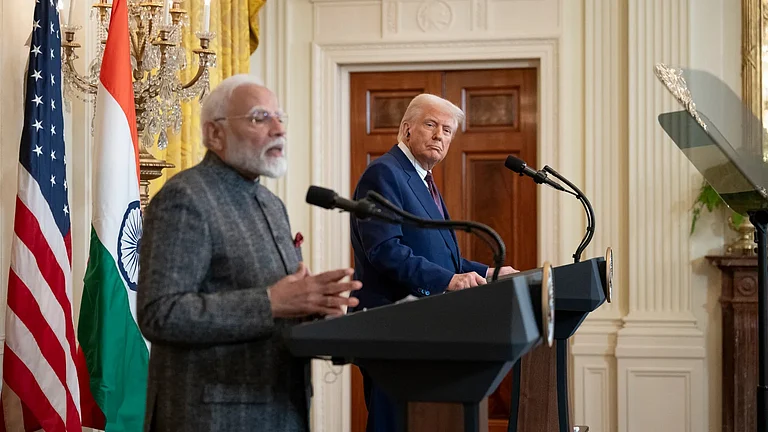In Kanpur's Fazal Ganj, 50-year-old Manish Dhawan stares at the rows of half-finished leather bags that should have reached the US by now. This time last year, his company, Raj Exports, was buzzing with activity and in a rush to fill orders from American buyers.
But today, the sewing machines sit idle. Other than the Covid disruption, he has never seen such an abrupt slowdown. “Our US buyers don’t even respond to our calls or emails. And when they do, it’s just to say, ‘We’ll see what can be done’ or ‘Our hands are tied’. My orders have fallen sharply over the past few months,” he says.
Dhawan isn’t alone. Across factory floors in Jaipur and other gems and jewellery (G&J) export hubs like Agra and Surat the hub of activity has fallen silent.
Pain Points
September marked the first full month of the steep 50% tariff that the US imposed on many Indian goods. This tariff hike, which doubled the previous 25% duty, suddenly makes half of India’s exports to the US unreasonably expensive. The brunt is borne by India’s labour-intensive industries: textiles, apparel, leather products, G&J, footwear, handicrafts and seafood. These sectors together employ tens of millions of workers.
“This is usually the busiest quarter every year for the G&J exporters. Yet businesses heavily reliant on shipments to the US are now nearly idle,” says Rajiv Jain, former chairman of the Gem and Jewellery Export Promotion Council (GJEPC).
The rate imposed on India is one of the highest US tariff walls ever levied on any country’s exports, instantly rendering Indian products far more expensive for American buyers. Roughly two-thirds of India’s shipments to its largest market now fall under the 50% duty umbrella.
The scale of impact is sobering. Indian competitors from other countries face only 20–30% tariffs on similar goods. Say a gold necklace or leather wallet from India will now cost nearly double than those from Vietnam.
India’s textiles and apparel exports to the US stood at $10.8bn in 2024–25, with apparel’s share being $5.4bn, contributing to 35% of India’s apparel exports. Tariffs have now surged from 13.9% to 63.9%, effectively shutting Indian garments out of their largest market, given that margins were already in single digits.
Destination US
Meanwhile, US buyers are rapidly reconfiguring supply chains—Bangladesh and Vietnam are being tapped for garments, denim and manmade fibres; Pakistan is gaining in denim and fleece; Cambodia is emerging in fast-fashion knits; and Mexico, along with CAFTA-DR countries (a trade bloc made up of the US and five Central American nations), are expanding near-shore replenishment.
The US is also the largest market for Indian carpets and rugs, with a 58% share in exports. This sector now faces 52.9% tariffs instead of 2.9% earlier. American buyers are now reportedly shifting to Türkiye and China, along with Turkish-owned mills in Egypt.
The US was the largest importer of leather and leather products from India too and accounted for 21.8% of the country’s total leather exports in 2024–25, followed by Germany (11.3%). Dhawan says that his exports to Germany have already suffered because of the Russia-Ukraine war. One of his German buyers used to buy €40,000 worth of goods every month, which has now dropped to €8,000.
Order cancellations from major hubs like Agra and Kanpur are triggering layoff concerns even as the immediate impact of tariff pressures on employment may be slow to surface.
This is mainly because of India's stringent labour laws. “If you have to lay off a worker, you must pay huge compensation, gratuity, insurance and other benefits. But at the same time, there’s no safety net for factory owners in an uncertain environment,” says Dhawan. He wants the government to give some immediate relief to tariff-affected sectors.
Many exporters had anticipated trouble and front-loaded shipments before the tariff kicked in. During the first half of the current fiscal year, India's exports to the US had grown to $45.8bn compared to $40.4bn during the same period last year. But those stop-gap moves only cushioned the initial blow. As soon as the full tariff kicked in, new orders from the US dried up.

Demand and Dilemma
The immediate fallout is already visible in trade data. India's trade deficit widened to a 13-month high of $32.2bn in September. Exports to the US fell to $5.4bn from $6.9bn in the previous month.
According to Sabyasachi Ray, executive director at GJEPC, exports of gems and jewellery from Mumbai’s SEEPZ special economic zone to the US dropped sharply by 76% in September year on year.
Now, as the dust settles, a tense round of renegotiations has begun. Jain says that US buyers expect Indian exporters to absorb the tariff—a burden almost no one can shoulder.
For exporters, these demands present an agonising dilemma. Most already operate on razor-thin margins to begin with, especially in highly competitive sectors.
Yet refusing outright is equally perilous—it risks driving the buyer straight into a competitor’s arms in Vietnam, Bangladesh or elsewhere. Share the cost and lose money or refuse and lose the client: it’s more like a lose-lose proposition.
The brunt (of tariffs) is borne by India’s labour-intensive industries: textiles, apparel, leather products, jewellery, footwear, handicrafts and seafood. These sectors together employ millions of workers
Indian exporters, known for their resilience, are pleading for lifelines to weather the crunch. In August, right after 50% tariffs came into force, GJEPC submitted a memorandum to the government outlining relief measures. Among their top asks: a six-month moratorium on repayments of working-capital loans for US-linked orders, restoring interest subsidy schemes for export credit and a temporary rebate covering part of the additional tariffs to help blunt the cost increase. They’ve also sought permission to redirect inventory, for instance, allowing jewellery destined for the US to be sold in the domestic market or elsewhere without penalty.
Ray says that the government has not provided any such measures yet. So far, policymakers in New Delhi have been sympathetic but non-committal. Some measures on the margin have been enacted—for example, GST rates were cut on certain goods to spur domestic demand. However, for many exporters, tapping into the domestic market is far from simple. They would have to compete with well-entrenched domestic brands with committed customers.
New Markets
Industry veterans say that the government’s room to offset a US-imposed tariff is limited, as a large direct subsidy could violate global trade rules. Still, without some immediate cushion, many businesses fear they will not last to see a long-term solution. Meanwhile, hiring and workforce decisions already hang in the balance.
"Something to ease the cash crunch, even if it’s just faster duty refunds or emergency credit lines could make the difference between survival and bankruptcy for some firms," says Dhawan, while expressing a sense of duty to their long-time workers and still has not thought of laying them off.
According to a commerce ministry official, to enable diversification, the Export Credit Guarantee Corporation has reviewed and upgraded the rating of 24 countries in Asia, Africa, Central and Latin America, as well as Europe, thereby facilitating exporters with lower premium cost and de-risking their exports.
“It is easier said than done. The other markets are not open for us because they already have vendors. Europe, for instance, can’t absorb the same volume that the US does,” says Jain the former GJEPC chairman.
Historically, India's exports have been concentrated in a few particular products and regions. For instance, in 1990, the Soviet Union was the top buyer of Indian goods, with India exporting 16.1%, followed by the US (14.7%). In 2000, the US became India’s top partner with a 21.9% share, followed by Hong Kong, China (6.5%), the United Arab Emirates (UAE, 5.8%) and the UK (5.2%). Today, India’s trade is dominated by the US, China and the UAE.
India's global export share grew from 1.2% in 2005 to only 2.4% in 2023. Product-wise too, India’s high-tech exports—particularly in mobile phones and services—have grown sharply over the past decade. However, the country has ceded ground in low-skilled sectors such as apparel, leather and textiles to Bangladesh and Vietnam, which capitalised on China’s retreat from labour-intensive manufacturing, a World Bank report said.
Diversification cannot occur overnight, especially at a time when high US tariffs are affecting many countries and several countries are trying to diversify simultaneously. Jyoti Vij, director general, Federation of Indian Chambers of Commerce and Industry, points out that apart from competitions, exporters also struggle to shift supply chains quickly due to long-term contracts and regulatory hurdles, making it even tougher for MSMEs.
Future Tense
Hence, the competition is fierce, unlike the past seven or eight years when third-country competition was relatively limited. While diversification makes sense strategically, Sonal Varma, Japanese financial firm Nomura's India chief economist, emphasises having a product- and geography-wise game plan.
"For instance, in the EV [electric vehicle] space, China is dominant, but in small cars, demand is growing in Africa and parts of Latin America. Those markets, with similar consumption patterns to India, might make more sense than, say, Asean [a Southeast Asia trading group] countries, where Chinese competition is already intense," she explains.
Indian exporters’ are staring at a winter of woes. And it might turn out to be a long one. Trade talks have yet to be conclusive. Only time will tell how many will survive Trump’s tariff tsunami.












